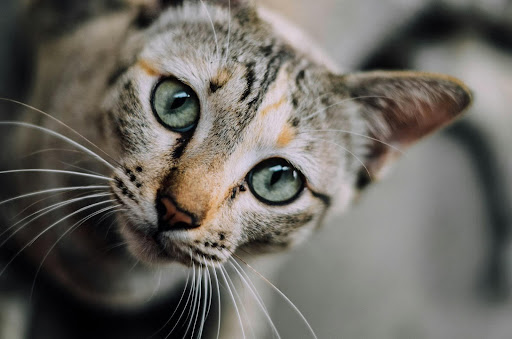Cats have a natural defense mechanism to protect their eyes from dirt, bacteria, and other harmful substances. This is the tear film, a thin layer of moisture that covers the surface of the eye and keeps it clean and healthy.So, Why Are My Cats Eyes Watering
However, sometimes this tear film can become excessive, causing your cat’s eyes to water more than usual. This can be a normal response to some environmental factors, such as dust or pollen, but it can also indicate a more serious problem, such as an infection, an injury, or a growth.
In this article, we will explain some of the common causes of watery eyes in cats, how to recognize the signs of trouble, and what to do if your cat needs medical attention. We will also give you some tips on how to prevent eye problems in your cat and keep their eyes in good shape.
What Does It Mean When a Cat Has Teary Eyes
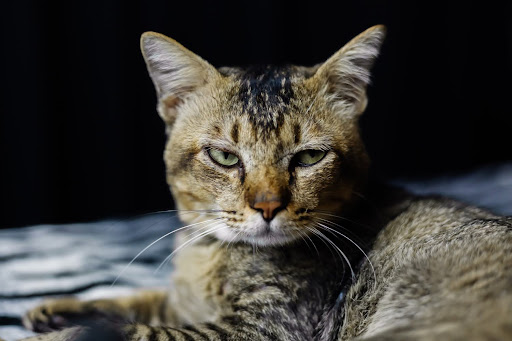
Has your furry friend been shedding more tears than usual? Don’t worry, you’re not imagining things! While cats do cry (just not in the emotional way humans do), excessive watering can point to something more than just a sad movie scene.
When your furry companion’s eyes start welling up, it can stir up concern. Understanding the reasons behind their teary eyes is key to keeping your pet healthy and happy.
Your cat’s eyes serve as windows to their world, typically bright and clear. A healthy gaze reveals a crisp view of their black pupils and colorful irises.
Occasional watery discharge, clear in color, might not raise alarms. Yet, if it becomes a recurring issue or if the discharge turns yellow or sticky, it’s time to take notice. Additionally, watch out for other signs like cloudy eyes, pawing at their face, or excessive blinking or squinting – they could all signal discomfort.
8 Common Causes of Watery Eyes in Cats
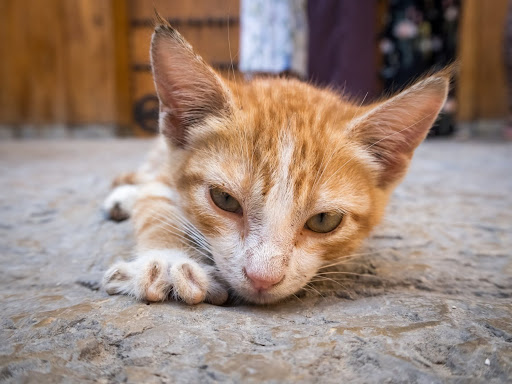
Those glistening peepers might not be tears of joy after all. Watery eyes in cats, while common, can signal a range of issues, from allergies to more serious conditions. Let’s peel back the layers and explore the 8 most likely issues:
Conjunctivitis or Pink Eye
This is an inflammation of the pink tissue (conjunctiva) inside the eyelids, caused by bacteria, viruses, allergies, or irritants. It can make the eyes red, swollen, and watery. Conjunctivitis can affect one or both eyes, and it can be contagious to other cats or humans.
Allergies
Cats can be allergic to pollen, dust, mold, perfume, cleaning products, or other substances that can irritate their eyes and cause them to water. Allergies can also cause sneezing, itching, or skin problems.
Eye Infection
This can be caused by various microorganisms, such as feline herpesvirus, feline calicivirus, or fungi, that infect the eye and cause inflammation, discharge, and tearing.
Eye infections can also lead to ulcers or sores on the cornea, the clear layer that covers the eye. Eye infections can be chronic or recurrent, and they can affect the vision and comfort of the cat.
Blocked Tear Ducts
This is when the duct that drains tears from the eyes to the nose is obstructed by debris, inflammation, or tumors. This prevents the tears from flowing normally and causes them to spill over the eyelids.
Blocked tear ducts can also cause dry eye, epiphora, or glaucoma, which are conditions that affect the tear production or pressure in the eye.
Entropion and Ectropion
These are abnormalities of the eyelids that cause them to roll in or out, respectively. This can make the eyelashes or the skin rub on the cornea and cause irritation, pain, and watery eyes.
Entropion and ectropion can be inherited or caused by injury, infection, or aging. They can affect one or both eyes, and they can lead to corneal damage or infection.
Trauma or Eye Injury
This can be caused by scratches, ulcers, foreign objects, or chemicals that damage the surface of the eye and cause pain, swelling, and excessive tearing.
Trauma or eye injury can occur during fights, accidents, or grooming. They can affect one or both eyes, and they can result in corneal scarring, infection, or loss of vision.
Flat-face Breed Disorder
This is a condition that affects some breeds of cats, such as Persians, Himalayans, and Exotic Shorthairs, that have short faces and round skulls.
This can affect the shape and function of their tear ducts, causing tears to spill over onto their faces. This can stain their fur and irritate their skin.
Environmental Factor
This can be caused by changes in weather, sun or wind exposure, irritants, or foreign objects that can affect the eyes and cause them to water. Environmental factors can also cause sneezing, coughing, or nasal discharge.
Symptoms to Watch For
Watery eyes in cats can be accompanied by other symptoms that indicate a problem with their eye health. Some of the symptoms that you should look out for include:
- Redness: of eyes, skin under eyes, or conjunctiva
- Inflammation: of eyes or skin under eyes
- Discharge: watery, clear, sticky, yellow, green, or reddish-brown
- Pain or Discomfort: pawing at eyes, squinting, or obvious discomfort
- Vision Changes: impaired vision, cloudiness in the eyes
- Swelling: of eyelids, skin under eyes, or conjunctiva
- Eye Rubbing or Pawing: frequent blinking, rubbing, or pawing at eyes
- Squinting: excessive squinting or narrowing of eyes
- Nasal Discharge: sneezing, discharge from nose
- Fur Loss or Staining: fur loss around eyes, reddish-brown staining beneath eyes
How Do You Treat a Cat’s Weepy Eyes
If your cat has weepy eyes, you can provide some home care to relieve their discomfort and prevent further complications. Some of the things you can do include:
- Never self-medicate: Avoid using human eye drops or ointments on your cat, as they can be harmful.
- Clean Gently: Use a soft, damp cloth with warm water to gently wipe away any discharge. Avoid using harsh soaps or chemicals.
- Address Underlying Issues: If the cause is allergies, remove allergens from the environment. If it’s a scratch, use a cone to prevent further rubbing.
- Warm Compresses: Apply warm compresses for a few minutes to soothe irritation and promote drainage.
When to Seek Veterinary Care
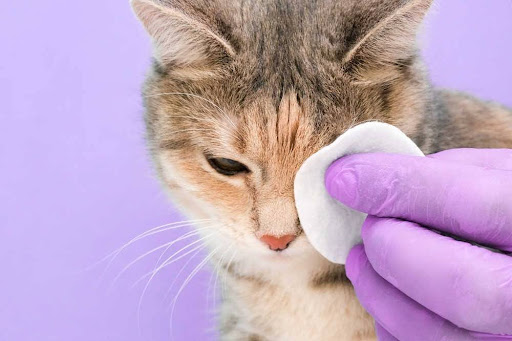
If your cat’s eyes are watering a lot and it doesn’t get better after a day or two, it’s time to see the vet. They’ll check your cat’s eyes and figure out what’s wrong. Getting help early can make your cat feel better faster and prevent things from getting worse.
If your cat’s eyes look painful or have weird stuff coming out of them, call the vet right away. Eye problems can get worse quickly, but the vet can help if you act fast. It’s important to keep an eye on your cat’s eyes and go to the vet if you’re worried, even if your cat is a special breed that’s more likely to have eye problems.
Diagnosis and Treatment
Your veterinarian will need some information about your cat’s medical history and behavior to help them diagnose the cause of their watery eyes. They may also perform some of the following tests:
- A physical examination: The vet will give your cat a once-over to spot any visible signs of trouble.
- Allergy test: This helps rule out allergies as the culprit behind those watery eyes.
- Fluorescein stain test: Using a special stain and a blue light, the vet can detect any hidden trauma to the eye without causing any discomfort to your cat.
- Schirmer tear test: This nifty little test measures tear levels in the eye, providing insight into potential issues.
- Tonometry test: By evaluating the pressure inside your cat’s eye, the vet can check for conditions like glaucoma.
- Imaging tests: X-rays, MRI, or CT scans might be used to peek inside your cat’s skull for any internal abnormalities.
- Laboratory analysis: If there’s any discharge from the eye, the vet may analyze it in the lab to pinpoint the cause.
The specific treatment regimen depends on the diagnosis made by the veterinarian.
First, if a foreign body is found in the eye during the examination, it needs to be removed quickly to prevent further irritation and potential damage. This procedure is usually performed under sedation to ensure your cat remains calm and cooperative.
In cases where allergy is identified as the underlying cause, antihistamine treatment may be prescribed to relieve symptoms and reduce the frequency of watery episodes. This medication helps to moderate the immune response triggered by the allergen, giving your cat some much-needed relief.
When a bacterial or viral infection is identified, topical antibiotics are often used to combat the pathogens responsible. These medications are applied directly to the affected eye, targeting the infection at its source and promoting healing.
To manage the pain and inflammation associated with watery eyes, your veterinarian may prescribe pain relievers and anti-inflammatory medications. These medications help reduce discomfort and swelling, allowing your cat to feel more comfortable during the healing process.
In cases where structural abnormalities are identified, such as tear duct blockage or abnormal eyelid structure, surgical intervention may be necessary. Procedures such as tear duct catheterization or eyelid repair are intended to restore normal function and prevent further complications.
Specialized treatments may also be employed for specific conditions. For example, distichiasis, a condition characterized by abnormal growth of the eyelids, can be treated using cryosurgery to remove the offending hair. Similarly, eyelid tumors may require aggressive treatment, often with surgical removal to prevent further spread.
Tips for Maintaining Your Cat’s Eye Health
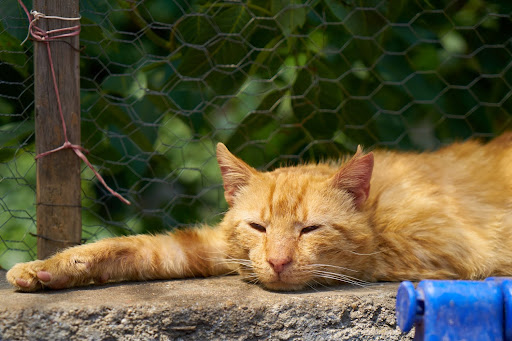
Your cat’s eyes are among their most beautiful and important features, so as a cat parent, it’s our duty to keep them healthy. Here are some tips to help you maintain your cat’s eye health:
- Clean your cat’s eyes with a warm cloth or wipe to remove crust or discharge and prevent infection and irritation.
- Check your cat’s eyes for any changes, such as redness, cloudiness, swelling, pain, or sensitivity, and contact your vet if you see any.
- Feed your cat a balanced diet. In particular, choose a commercial cat food that contains real meat as the first ingredient, and is appropriate for your cat’s age and life stage.
- You can also supplement your cat’s diet with natural antioxidants, such as blueberries, cranberries, or carrots, which can help protect the eyes from oxidative damage.
- Schedule yearly vet checkups to examine your cat’s eyes and diagnose and treat any eye problems.
FAQs
Can I use over-the-counter eye drops for my cat’s watery eyes?
Absolutely not! Human eye drops can be harmful to cats and worsen their condition. Always consult your vet for proper medication.
How often should I take my cat to the vet for eye problems?
Yearly checkups are crucial, but visit sooner if you notice any eye issues like redness, squinting, or discharge.
Are there any home remedies I can try for my cat’s watery eyes?
Avoid them! Stick to gentle cleaning with a damp cloth and water recommended by your vet. Home remedies can irritate the eyes further.
Should I be concerned if my cat’s eyes are watering only occasionally?
Brief, occasional watering might not be a concern, but monitor closely. If it persists, worsens, or shows other symptoms, consult your vet.
Can dental problems cause watery eyes in cats?
Yes, dental problems can cause watery eyes in cats, especially if the infection or inflammation affects the upper teeth or the roots of the teeth. This can cause pressure on the nasolacrimal duct, which drains tears from the eyes to the nose, and block the tear flow. This can result in watery eyes, as well as nasal discharge, bad breath, and difficulty eating.
Final Thoughts
While occasional tearing in cats is normal, excessive or persistent watery eyes can indicate underlying health issues that require attention.
By understanding the potential causes of this symptom and seeking timely veterinary care, you can help ensure your cat maintains optimal ocular health and enjoys a comfortable, happy life.
If you found this article helpful, we encourage you to share it with fellow cat owners who may benefit from this information. Additionally, feel free to leave a comment below sharing your experiences or questions related to your cat’s eye health.
Your feedback is valuable to us!

